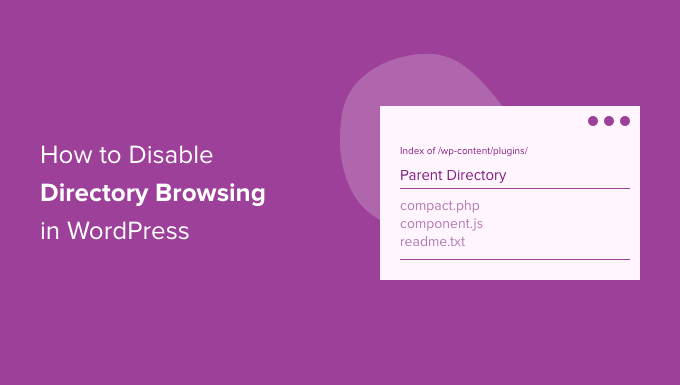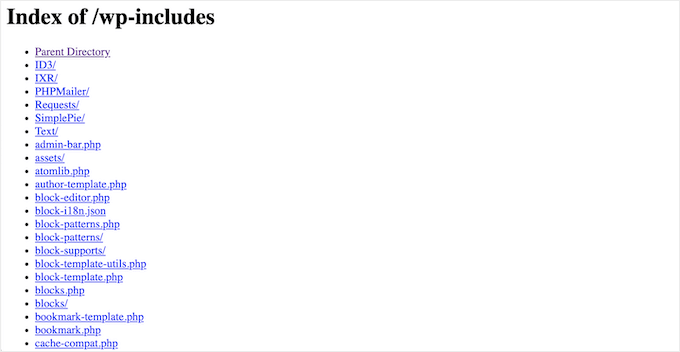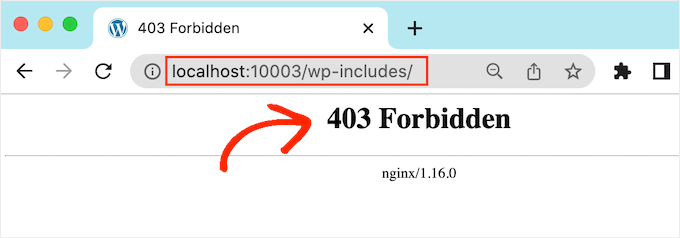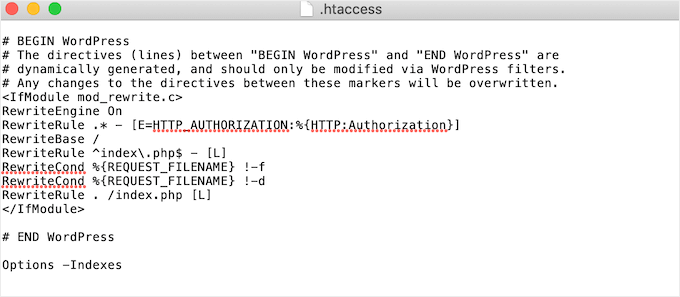Nous avons vu de nombreux sites qui ne désactivent pas la navigation dans les répertoires. Malheureusement, cette minuscule erreur peut exposer des informations sensibles à des pirates informatiques et peut nuire à un site.
La consultation de répertoires permet à d’autres personnes de voir les fichiers et dossiers de votre site. Les pirates peuvent alors utiliser ces informations pour trouver des vulnérabilités dans les extensions, les thèmes ou votre serveur d’hébergement.
Cette simple étape peut améliorer considérablement la sécurité de votre site. Il s’agit d’une correction rapide que tout propriétaire de site devrait connaître.
Dans ce guide, nous allons vous afficher comment désactiver la navigation dans les répertoires sur WordPress. Cela vous aidera à protéger votre site et à garder vos données en sécurité.

Quel est l’effet de la désactivation de la navigation dans les répertoires sur WordPress ?
Lorsqu’un internaute accède à un site web, le serveur web traite sa demande. En règle générale, le serveur envoie un fichier d’index, tel que index.html, au navigateur.
Si un fichier d’index est manquant, le serveur peut afficher une liste de tous les fichiers et dossiers de ce répertoire. Ce comportement, connu sous le nom de navigation dans les répertoires, est généralement activé par défaut sur les serveurs hébergeurs.
Nous avons vu de première main comment la navigation dans les répertoires peut exposer des informations sensibles sur la structure d’un site. Ces informations pourraient être utilisées pour identifier des vulnérabilités dans les extensions, les thèmes ou même les configurations d’hébergeurs.
Les internautes peuvent être confrontés à la navigation dans les répertoires lorsqu’ils voient une simple liste de fichiers et de dossiers au lieu d’une page web. Cet accès involontaire peut prospecter des risques de sécurité s’il n’est pas pris en compte.

Les pirates exploitent souvent la navigation dans les répertoires pour voir les fichiers d’un site, y compris les thèmes et les extensions. Si l’un d’entre eux présente des vulnérabilités connues, les attaquants peuvent utiliser ces informations pour compromettre le site.
Dans de nombreux cas, la navigation dans les répertoires peut également exposer des contenus privés ou payants, tels que des téléchargements de livres électroniques ou des cours en ligne. Cela peut prospecter des copies non autorisées et entraîner des pertes de revenus.
La désactivation de la navigation dans les répertoires est un moyen simple mais efficace de prévenir ces risques. C’est l’une des premières étapes par étapes que nous recommandons pour sécuriser un site WordPress.
Comment vérifier si la navigation dans les répertoires est activée dans WordPress
Un moyen facile de vérifier si la navigation dans les répertoires est activée sur votre site WordPress est de visiter directement le dossier /wp-includes/.
Par exemple, il suffit de saisir une URL comme celle-ci : https://example.com/wp-includes/ dans votre navigateur.
Confirmez donc que vous remplacez exemple.com par le nom de domaine de votre site. Ce test simple fonctionne dans la plupart des programmes d’installation de WordPress.
Si vous voyez un message 403 Forbidden ou une erreur similaire, c’est que la navigation dans les répertoires est déjà désactivée. C’est un bon signe, car cela signifie que votre site est plus sûr.

Si une liste de fichiers et de dossiers apparaît à la place, cela signifie que la navigation dans les répertoires est activée.
Les sites sont donc vulnérables aux attaques malveillantes.

D’après notre expérience, l’activation de la navigation dans les répertoires expose des informations sensibles et augmente les risques de sécurité. Pour cette raison, il est préférable de désactiver la navigation dans les répertoires dans WordPress afin de préserver la sécurité de votre site.
Comment désactiver la navigation dans les répertoires sur WordPress
Pour désactiver l’inscription au répertoire, vous devez ajouter du code au fichier .htaccess de votre site.
Pour accéder au fichier, vous aurez besoin d’un client FTP, ou vous pouvez utiliser l’application de gestion de fichiers dans le panneau de contrôle de votre hébergeur WordPress.
Si c’est la première fois que vous utilisez le protocole FTP, vous pouvez consulter notre guide complet sur la façon de se connecter à votre site à l’aide du protocole FTP.
Après vous être connecté à votre site, ouvrez simplement le dossier public de votre site et trouvez le fichier .htaccess. Vous pouvez ensuite modifier le fichier .htaccess en le téléchargeant sur votre ordinateur, puis en l’ouvrant dans un éditeur/éditrices de texte tel que le Bloc-notes.
Tout en bas du fichier, il suffit d’ajouter le code suivant :
1 | Options -Indexes |
Il se présentera comme suit :

Une fois que vous avez terminé, enregistrez votre fichier .htaccess et téléversez-le sur votre serveur à l’aide d’un client FTP.
Voilà, c’est fait. Maintenant, si vous visitez la même URL http://example.com/wp-includes/, vous obtiendrez un message 403 Forbidden ou un message similaire.

Astuce d’expert : Si vous soupçonnez que votre site WordPress a été piraté, alors consultez notre guide pour corriger un site WordPress piraté. Sinon, vous choisissez notre service professionnel de réparation de site WordPress piraté et vous engagez des experts professionnels en sécurité WordPress pour nettoyer votre site immédiatement.
Lecture complémentaire :
Vous souhaitez que votre site WordPress soit sécurisé et exempt d’erreurs ? Vous trouverez peut-être les articles suivants utiles :
- Guide du débutant sur la structure des fichiers et des répertoires de WordPress
- Les erreurs les plus courantes de WordPress et comment les corriger
- Comment corriger l’erreur de droits sur les fichiers et les dossiers dans WordPress ?
- Comment protéger par mot de passe votre répertoire d’administration WordPress (wp-admin)
Nous espérons que cet article vous a aidé à apprendre comment désactiver la navigation dans les répertoires sur WordPress. Vous pouvez également consulter notre guide ultime de sécurité WordPress ou voir notre choix d’experts des meilleures extensions de sécurité WordPress.
Si vous avez aimé cet article, veuillez alors vous abonner à notre chaîne YouTube pour obtenir des tutoriels vidéo sur WordPress. Vous pouvez également nous trouver sur Twitter et Facebook.





Jiří Vaněk
Thanks for the advice. On directory browsing, or that I have it enabled, the AIO SEO plugin keeps warning me. I have currently solved the problem by making the folders have an index file that is empty. Is it possible to take this as one of the possible solutions?
WPBeginner Support
You can try that method but we would still recommend the htaccess method from our guide.
Admin
Jiří Vaněk
Thanks for the advice, I finally used the Options -Indexes method now and AIO SEO already reports the problem as solved. Thanks again.
Ka Khaliq
After editing the htaccess file as per the provided guidelines, I do see 403 Forbidden message for /wp-includes/. But I’m unable to see edit any post. Upon editing a post, I see the same 403 Forbidden message. How to solve this?
WPBeginner Support
There may be an issue with your file permissions, we would recommend taking a look at our guide below for fixing your permissions:
https://www.wpbeginner.com/wp-tutorials/how-to-fix-the-403-forbidden-error-in-wordpress/
Admin
Ka Khaliq
The issue resolved after clearing the web history/cache.
Thanks for your time.
Dina D
Thank you so much! Clear, concise, and easy to follow. Thank you so much!
WPBeginner Support
You’re welcome!
Admin
Rabee Khan
Thank You… precise and easy to understand!
WPBeginner Support
Glad our guide was helpful!
Admin
Kimmy
Thanks for the two-word solution! Lol. Worked perfectly!
WPBeginner Support
Glad we could help!
Admin
Seashell
I was shocked to see the folders accessible right in the browser.
Thanks for your solution!
WPBeginner Support
Glad we could help!
Admin
Deepak Kumar
Its work like charm. Article on wpbeginners like ready to go solution. Keep it up.
Ayo
How do I now solve the 404 error that comes after?
Pradip Singh
I am in love with this website. Every day I am surprised when I read a new article from this website. Thankfully I read this article today and immediately I implemented the advice.
WPBeginner Support
Glad you found our content helpful
Admin
Sourabh
Will it block CDNs from accessing my website for static content?
WPBeginner Support
No, it will not.
Admin
sami
Does this method affect google crawling .. is it SEO friendly?
WPBeginner Support
It should not affect search engines crawling your site.
Admin
Meera Shaikh
Thanks its Done
WPBeginner Support
You’re welcome
Admin
Pradeep
Thanks my friend, I just try this and it’s work.
You are the genius.
WPBeginner Support
Glad our guide was helpful
Admin
mousam
Thank you. I applied and it worked.
You guys are the best source for learning wordpress.
WPBeginner Support
You’re welcome, glad our guide was helpful
Admin
Kevine
Thank you very much for this. It solved my problem.
Thanks again.
WPBeginner Support
You’re welcome, glad our guide was helpful
Admin
malika
Thank you for sharing information!
WPBeginner Support
You’re welcome
Admin
Jonthan
So is it ok to have this code on .htaccess file even when an index.php file is present in the root folder.
Kindly respond.
WPBeginner Support
Yes
Admin
Teresa Cuervo
Do you need Filezila to do this or can you go to the FTP via Cpanel and do this?
Thank you
WPBeginner Support
You can use either, not all hosts have a file manager is why we show Filezilla
Admin
michael
Hello
does this action affect pages indexing on search engines?
and does it make some problems for indexed pages of my WordPress website?
Thanks
WPBeginner Support
No, it would not affect that negatively.
Admin
Rhen Castrodes
Thank you. it works
WPBeginner Support
Glad our recommendation was able to help you
Admin
John
Thank you! It works even now in 2020.
WPBeginner Support
You’re welcome
Admin
Shams
Amazing post,
Just have simple question, I added this code and it’s working, the question is Google indexes those page e.g sitecom/wp-contents/2019/2, will Google remove those pages automatically now as these are 404. Or I should remove it in Search Console?
Thanks
WPBeginner Support
This code should not make your direct links to images and files turn into 404s
Admin
Bill
Hello!
I recently applied this rule
and at the same day the front page of my blog
got vanished from google index.
Do you see any connection?
WPBeginner Support
Adding this to your htaccess should not affect your indexing, there are multiple reasons and you would want to check your Google Search Console for what it says about your home page.
Admin
Ionel G
Thanks for all the tips that you provide!
I am still wondering how can you hide the wp-content & wp-include folder from sources? I hate it when someone goes right click and source it can see all of my plugins :). Do you have any script for this?
Thank you in advance!
WPBeginner Support
We do not have a recommended method for that at the moment, the most common reason you can’t see those folders in dev tools is a site’s cache.
Admin
Mayur
Could you please tell me How can i disable WordPress in sub folder like my WordPress install on [www.mydomain.com] and i want to disable wordpress in [www.mydomain.com/customscript]
WPBeginner Support
You may want to first take a look at creating a custom page template: https://www.wpbeginner.com/wp-themes/how-to-create-a-custom-page-in-wordpress/
Otherwise, you would need to create a folder with that name and inside that folder add an index.html file for a nonWordPress page to appear.
Admin
Rafael
Thank you. Worked perfectly for all browsers.
Dipankar
but wp-content is showing . how to remove it as well.
Deatram
I disabled directory browsing, but still someone can see my directory when they use developer tools in chrome browser. How do I disable in that as well?
Faeze
I added the line that you said in .htaccess but it showes my directories yet .
What should I do now??
Nathan
When I click “Save Changes” on the Permalink Settings page the .htaccess file is updated, erasing the “Options -Indexes” code that I inputted. The code works fine, but I am concerned I will unknowingly delete it while performing some other task. Are there any other dashboard settings changes that I should know about that may affect the .htaccess file and erase the code? Thanks
Tôi Sống
Awesome, it work very good!
Baggio
Huge fan of wpbeginner, Optin Monster – I got so many useful tips and tricks on WP – and I have to say, the site design is just brilliant. And of course, the content here is epicly useful.
Thanks guys!
daniel
Hey! It doesnt seem to work. if i pull an image to another page its opened with a link of: example.com/wp-content/uploads/…
Any idea? thanks!
WPBeginner Support
Hey Daniel,
Your images and files inside directories can still be directly accessed. However, server will not let someone directly browse a directory and see its contents.
Admin
Axel Jebens
I would appreciate if you could iterate on this. I had a hard time when trying to get a solution for this issue. There are some ideas based on a htaccess redirecting to a php file that first checks if the user is logged on. Is there any plugin which provides such a function?
Ünal Hoca
Thank you
Khalid Mahmud
Thank you. It’s working…….
Kim
Sorry to late ask. I want to know, are these techniques safe to use regarding SEO score ? Hope you answer !
WPBeginner Support
Yes, they are.
Admin
Kimmy
Still works pretty well. Awesome, simple, and working. Thanks!
Charles
I have been writing this same code for weeks now but my directory remains visible to users. Pls what am doing wrong? Or could it be that my site is still loading from cached contents? Everybody says it is working but my own experience is different. Any help will be appreciated! Thanks in anticipation of your reply.
Kimmy
What part are you having trouble on? What is your hosting provider btw?
Lily
Thank you. Worked like a charm!
Prakash
This Above Trick Is Not Working Man….
Mike
Is there a way to allow viewing a directory but just hide the Parent Directory link for a specific page? This would be a network share folder that multiple people would access, and have sub folders which would still require a parent directory listing. I just don’t want anyone going above the shared folder.
Christian Nastari
This didn’t work for me. I tried before and after #END WordPress and didn’t work. I also tried “Options All -Indexes”, but didn’t work either
hrwhisper
very helpful, thank you very much
nitai
Really great. today I just faced and thinking how can I disallow like joomla and I found the exact solution.
Rob Myrick
This was very helpful and quick – thank you
Anita in SD
Thanks so much, was dismayed to see images from my site going to a parent directory :0. This was very helpful and worked well.
Blessings – A
Heather Jacobsen
Thanks for this tutorial. It worked great for hiding my uploads from anyone just wanting to browse that directory. One question, though. Does this by chance turn off the ability of search engines to browse my website. Sorry if it seems like a dumb question. I am a newbie, after all.
Wasil Burki
I added the Options -Indexes code to the htaccess file, however now I am not able to access the site I get a 503 error. Am I doing something wrong? Need help bad!! Thanks
Ted
The problem I have is that I can see the directory of this wordpress site, so if you are using this solution then it doesn’t work… (theme wpbv4)
Rahul
Thank you so much for the tutorial!
I was very concerned when I discovered some of my theme directories could be browsed. All good now, thanks to your tutorial. I never knew .htaccess packed in so much punch.